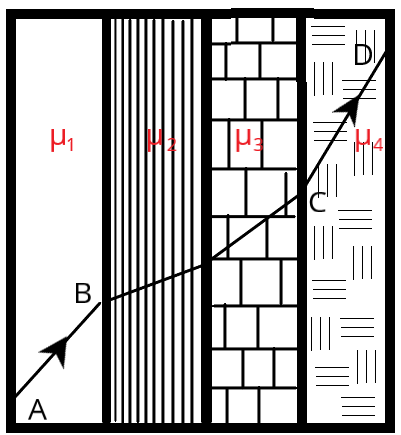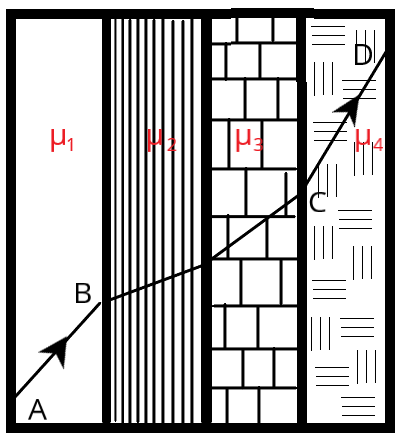
A ray of light passes through four transparent media with refractive indices \[{\mu _1},{\mu _2},{\mu _3}\]and \[{\mu _4}\] as shown in fig. The surfaces of all media are parallel. If the emergent ray \[CD\] is parallel to the incident ray\[AB\], we must have

A. \[{\mu _1} = {\mu _2}\]
B. \[{\mu _2} = {\mu _3}\]
C. \[{\mu _3} = {\mu _4}\]
D. \[{\mu _4} = {\mu _1}\]
Answer
219.9k+ views
Hint:Refraction is the phenomenon of bending in the path of light due to a change in speed when it travels from one medium to another medium. And the relationship between the refractive indices of the two media and the angles of incidence and refraction is provided by Snell's law of refraction. So, we need to apply Snell’s law of refraction to solve this kind of question.
Formula Used:
Snell’s law is represented as ${\mu _1}\sin i = {\mu _2}\sin r$
Here, ${\mu _1}$ is the refractive of the medium in which the light ray is incident, ${\mu _2}$ is the refractive index of the medium in which the light ray enters after refraction and i and r are the angles of incidence and refraction.
Complete answer:
In order to know that according to Snell’s law:
${\mu _1}\sin i = {\mu _2}\sin r$
Here, if incident ray is parallel to final emergent ray, then we have:

From the above figure, the refractive indices of the three transparent media from which the light is refracted determine solely the speed and trajectory of the light.
Given that the first and fourth media both refract light in the same direction, only when both rays go through the same medium with the same refractive index then the emergent ray $CD$ and incident beam $AB$ become parallel after passing through the media.
From Snell’s law at B, $(1)\sin \theta = {\mu _1}\sin r$…… (1)
And, Snell’s law at C, ${\mu _4}\sin r = (1)\sin \theta $…… (2)
Now, compare the equation (1) from (2), then we obtain:
${\mu _4}\sin r = {\mu _1}\sin r \\$
$\boxed{{\mu _4} = {\mu _1}} \\$
Therefore, ${\mu _4} = {\mu _1}$.
Thus, the correct option is: (D)${\mu _4} = {\mu _1}$
Note: It should be noted that the angle of incidence is greater than the angle of refraction when light travels from a rarer media into a denser medium.
The angle of incidence is smaller than the angle of refraction when light travels from a denser medium into a rarer one.
Formula Used:
Snell’s law is represented as ${\mu _1}\sin i = {\mu _2}\sin r$
Here, ${\mu _1}$ is the refractive of the medium in which the light ray is incident, ${\mu _2}$ is the refractive index of the medium in which the light ray enters after refraction and i and r are the angles of incidence and refraction.
Complete answer:
In order to know that according to Snell’s law:
${\mu _1}\sin i = {\mu _2}\sin r$
Here, if incident ray is parallel to final emergent ray, then we have:

From the above figure, the refractive indices of the three transparent media from which the light is refracted determine solely the speed and trajectory of the light.
Given that the first and fourth media both refract light in the same direction, only when both rays go through the same medium with the same refractive index then the emergent ray $CD$ and incident beam $AB$ become parallel after passing through the media.
From Snell’s law at B, $(1)\sin \theta = {\mu _1}\sin r$…… (1)
And, Snell’s law at C, ${\mu _4}\sin r = (1)\sin \theta $…… (2)
Now, compare the equation (1) from (2), then we obtain:
${\mu _4}\sin r = {\mu _1}\sin r \\$
$\boxed{{\mu _4} = {\mu _1}} \\$
Therefore, ${\mu _4} = {\mu _1}$.
Thus, the correct option is: (D)${\mu _4} = {\mu _1}$
Note: It should be noted that the angle of incidence is greater than the angle of refraction when light travels from a rarer media into a denser medium.
The angle of incidence is smaller than the angle of refraction when light travels from a denser medium into a rarer one.
Recently Updated Pages
Electricity and Magnetism Explained: Key Concepts & Applications

JEE Energetics Important Concepts and Tips for Exam Preparation

JEE Isolation, Preparation and Properties of Non-metals Important Concepts and Tips for Exam Preparation

JEE Main 2021 July 25 Shift 1 Question Paper with Answer Key

JEE Main 2021 July 22 Shift 2 Question Paper with Answer Key

States of Matter Chapter For JEE Main Chemistry

Trending doubts
JEE Main 2026: Application Form Open, Exam Dates, Syllabus, Eligibility & Question Papers

Understanding Uniform Acceleration in Physics

Derivation of Equation of Trajectory Explained for Students

Hybridisation in Chemistry – Concept, Types & Applications

Understanding the Angle of Deviation in a Prism

Understanding Atomic Structure for Beginners

Other Pages
JEE Advanced Marks vs Ranks 2025: Understanding Category-wise Qualifying Marks and Previous Year Cut-offs

Dual Nature of Radiation and Matter Class 12 Physics Chapter 11 CBSE Notes - 2025-26

How to Convert a Galvanometer into an Ammeter or Voltmeter

Understanding Centrifugal Force in Physics

JEE Main Marking Scheme 2026- Paper-Wise Marks Distribution and Negative Marking Details

Degree of Dissociation: Meaning, Formula, Calculation & Uses




